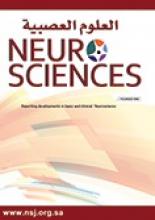Article Figures & Data
Tables
- Table 1
- Distribution of demographic and clinical characteristics of study subjects (n=420).
Characteristics n (%) Age 18-20
21-23
24-26
26-28161(38.3)
243(57.9)
14(3.3)
2(0.5)Gender Female
Male153(36.4)
267(63.6)Years First year
Second year
Third year
Fourth year
Fifth year72(17.1)
88(21.0)
119(28.3)
78(18.6)
63(15.0)Family income 1,000-10,000
11,000-20,000
21,000-30,000
Lower than 1,000
More than 30,00044(10.5)
94(22.4)
90(21.4)
17(4.0)
175(41.7)Grade point average 3.49–2
4.49–3
Above 4.5
Below 2.59(2.1)
127(30.2)
283(67.4)
1(0.2)Marital status Divorced
Married
Single2(0.5)
2(0.5)
416(99.0)Parents marital status Divorced
Married
Widow17(4.0)
382(91.0)
21(5.0)Smoking status Ex-smoker
Non-smoker
Smoker8(1.9)
389(92.6)
23(5.5)Housing House
Rented house
Students’ dormitory371(88.4)
40(9.5)
9(2.1)Clinical characteristics variables n (%) Have you lived most of your childhood with your parents? Yes
No401(95.5)
19(4.5)Have you ever experienced emotional, physical, or sexual abuse during childhood? Yes
No111(26.4)
309(73.6)Have you been diagnosed with any psychiatric condition? Yes
No64(15.2)
356(84.8)How often do you take part in physical training? More than three times a week
Never
Once a week
Two to 3 times a week81(19.3)
139(33.1)
97(23.1)
103(24.5) Probable alexithymia n (%) Non-alexithymia
Alexithymia
Possible alexithymia205(48.8)
113(26.9)
102(24.3)- Table 3
- Association between alexithymia and socio-demographic characteristics of study subjects.
Demographics Non-alexithymia Alexithymia Possible alexithymia Chi-Square value P-value Age 18-20
21-23
24-26
26-2865 (31.7)
130 (63.4)
8 (3.9)
2 (1.0)49 (43.4)
63 (55.8)
1 (0.9)
0 (0.0)47 (46.1)
50 (49.0)
5 (4.9)
0 (0.0)
12.3290.055 Gender Female
Male65 (31.7)
140 (68.3)54 (47.8)
59 (52.2)34 (33.3)
68 (66.7)
8.6910.013 Year First year
Second year
Third year
Fourth year
Fifth year26 (12.7)
42 (20.5)
53 (25.9)
47 (22.9)
37 (18.0)27 (23.9)
24 (21.2)
35 (30.9)
13 (11.5)
14 (12.4)19 (18.6)
22 (21.6)
31 (30.4)
18 (17.6)
12 (11.8)
14.1090.079 Family income 1,000-10,000
11,000-20,000
21,000-30,000
Lower than 1,000
More than 30,00013 (6.3)
41 (20.0)
48 (23.4)
12 (5.9)
91 (44.4)16 (14.2)
29 (25.7)
18 (15.9)
2 (1.8)
48 (42.5)15 (14.7)
24 (23.5)
24 (23.5)
3 (2.9)
36 (35.3)14.642 0.066 Grade point average 3.49–2
4.49–3
Above 4.5
Below 2.54 (2.0)
69 (33.7)
131 (63.9)
1 (0.5)1 (0.9)
29 (25.7)
83 (73.5)
0 (0.0)4 (3.9)
29 (28.4)
69 (67.6)
0 (0.0)
6.0970.066 Marital status Divorced
Married
Single0 (0.0)
1 (0.5)
204 (99.5)2 (1.8)
1 (0.9)
110 (97.3)0 (0.0)
0 (0.0)
102 (100.0)6.636 0.174 Parents marital status Divorced
Married
Widow8 (3.9)
188
(91.7)
9 (4.4)6 (5.3)
102
(90.3)
5 (4.4)3 (2.9)
92
(90.2)
7 (6.9)1.742 0.786 Smoking status Ex-smoker
Non-smoker
Smoker5 (2.4)
191 (93.2)
9 (4.4)3 (2.7)
102 (90.3)
8 (7.1)0 (0.0)
96 (94.1)
6 (5.9)3.686 0.450 House type House
Rented house
Students’ dormitory185 (90.2)
16 (7.8)
4 (2.0)99 (87.6)
12 (10.6)
2 (1.8)87 (85.3)
12 (11.8)
3 (2.9)6.047 0.749 Have you lived most of your childhood with your parents? No
Yes9 (4.4)
196 (95.6)8 (7.1)
105 (92.9)2 (2.0)
100 (98.8)
3.2690.213 Have you ever experienced emotional, physical, or sexual abuse during childhood? No
Yes164 (80.0)
41 (20.0)72 (63.7)
41 (36.3)73 (71.6)
29 (28.4)
10.2110.006 Have you been diagnosed with any psychiatric condition? No
Yes179 (87.3)
26 (12.7)87 (77.0)
26 (23.0)90 (88.2)
12 (11.8)
7.2720.026 How often do you take part in physical training? More than 3 times a week
Never
Once a week
Two to 3 times a week40 (19.5)
56 (27.3)
51 (24.9)
58 (28.3)16 (14.2)
49 (43.4)
27 (23.9)
21 (18.6)25 (24.5)
34 (33.3)
19 (18.6)
24 (23.5)
12.7070.048 - Table 4
- Comparison of mean values of Alexithymia items between male and female study subjects.
Items Gender Male (n=267) Gender Female (n=153) T-test of mean difference Mean±SD Mean±SD P-value CI of 95% T-value Alexithymia 51.434±11.560 54.843±13.147 0.006 0.984 – 5.832 88.071 Describing feelings 13,58±3.777 13.74±3.873 0.690 0.605 – 0.914 73.405 Identifying feelings 18.80±5.473 18.95±4.891 0.775 0.897 – 1.203 73.431 Oriented thinking 20.206±4.981 20.13±4.636 0.879 0.893 – 1.043 85.281






